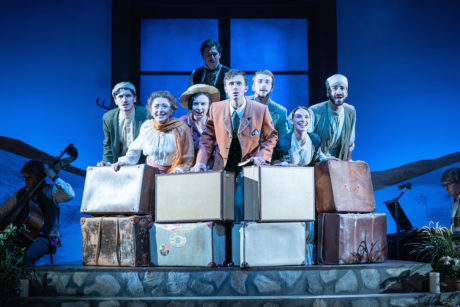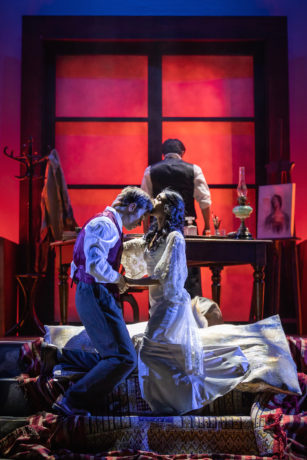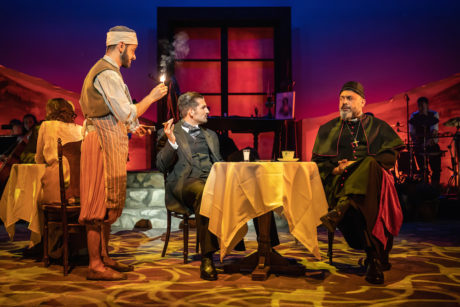
LONDON – Like much of Kahlil Gibran’s work, Broken Wings takes readers outside themselves, evoking a sense of yearning, hope and loss by setting the deepest human emotions against the backdrop of time’s ceaseless passage. The evocative quality of the great poet’s autobiographical book is captured brilliantly in a new musical of the same name, which opened this month at Theatre Royal Haymarket in London’s West End.
More details from Chauvet (www.chauvetprofessional.com):
Contributing to the unfolding of this moving story is the lighting design by Nic Farman that draws on the color rendering capabilities of CHAUVET Professional Ovation and Maverick fixtures. Like the Broken Wings plot itself, which has Gibran looking back from his New York studio at a love lost long ago in Beirut, Farman’s lighting transcends time, place and culture through the power of its colors.
“From our very early conversations, director Bronagh Lagan and I decided that lighting would play a role in conveying time and place,” said Farman. “In the play, the older Gibran is speaking to the audience from New York in the 1920s. During these scenes, I use a cool color palette with blues and cyans to locate him in his studio. The story he is telling is set in Beirut in the early 1900s. For these Beirut scenes, I use warm and rich oranges, along with yellows and reds, to convey the heat and dustiness of the setting. The New York and Beirut color palettes complement each other well. As we switch from scene to scene, the contrast is striking.”

Farman is using six Maverick MK2 Profiles, six Maverick MK1 Spots, six Ovation E-930VW with 36˚ lenses, six Ovation E-910FC fixtures with 36˚ lenses and six Ovation B-2805FC battens. The Maverick MK2 Profiles are split across FOH and overhead electrics. He has four of the units on FOH truss for front light specials. The remaining two profile fixtures are on LX1, and are used almost exclusively for specials and lighting on the upstage raised area and steps. Deployed overhead in rows of three, the Maverick MK1 Spot fixtures are used for back light specials, and as overhead gobo washes.
“The Maverick MK2 Profiles give me a bright shuttering FOH position,” said Farman. “Control of the space is important as I need to be able to close down to a tight area whilst the set is changed; the action in the show is very fluid. It is great to be able to call on the MK2s to shutter in tight, even over a large throw distance. As far as the overhead Maverick MK1 Spots go, they are giving me great options to wash the stage with texture, be it for the garden scenes in Beirut with their soft edged break-ups, or at the restaurant scenes where a hard-edged pattern outlines the space.”

Farman positioned his Ovation E-930VW fixtures on booms running the depth of the stage, using them for side light. Drawing on their output, he has them serve as full stage tunable white washes in addition to relying on them to color the stage at key moments. The Ovation E-910FC fixtures are used as high side lights for full stage color washes and as back light through the large scenic doors.
The Ovation B-2805FC battens light the two scenic wings that are behind the orchestra. “Being able to independently light these wings from the cyc became important to add contrast to the stage picture,” said Farman.
Coming in for special praise from Farman was the Ovation E-930VW. “I was particularly pleased to be able to use the Ovation E-930VW fixtures on this show,” he said. “I was relying on the quality of color temperature to build a lot of my looks for the production. I also used them to do some full color mixing, which they did well.”
Also standing out for Farman was the chance to work with Director Bronagh Lagan. “Working with Bronagh is great, because she allows me to let the light play a key role in expressing time, location and emotion,” he said. “For example, the coolness of the older Gibran scenes reveals the sorrow he experiences, knowing his love is dead. This color palette becomes more prevalent as the show continues, the warm sunlight being replaced by cooler tones so that by the time Selma (the poet’s lover) dies almost all warmth is stripped out of the lighting.
“Aside from color, the texture from our lighting was also important,” added Farman. “Our set designers Claudio Rosas and Mira Abad created a beautiful set with a lovely stone textured floor, so gobo washing across it is very effective. Also, a number of scenes take place in a garden, which I wash with subtle green shades that I turn to rose pinks as the scenes move into the evening.”

Farman’s lighting design flows seamlessly, but its creation was not without its bumps. “Our setup time was very tight,” he said. “Massive thanks to my production electrician Adam Mottley and his assistant Matt Harding, as well as my followspot operators Sam Hawkes and Rose Fraser and all the team at Royal Theatre Haymarket, for helping us get the show in and up on time.”
Racing against the clock during the setup of Broken Wings may seem ironic, given the play’s focus on the transcendental nature of time. Nevertheless, Farman and his team clearly won that race. The end result is a lighting design that’s every bit as timeless as the theme of this play and the work of its protagonist.
Photo Credit: Marc Brenner


